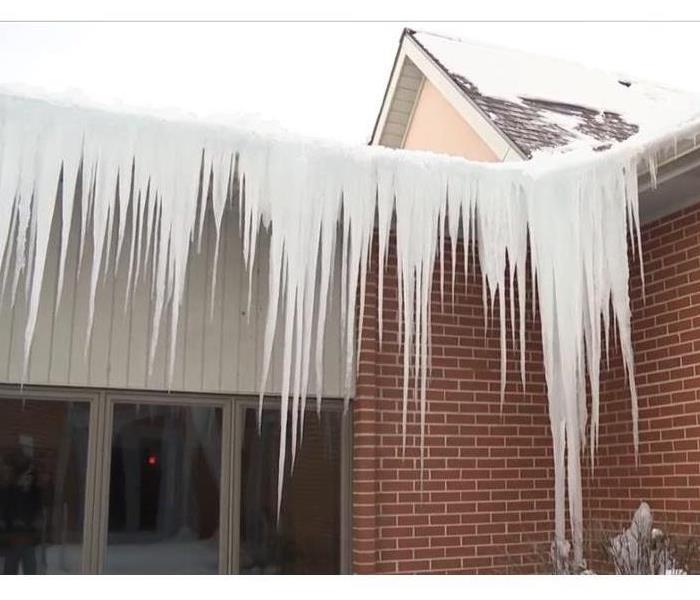What is an Ice Dam?
11/5/2018 (Permalink)
The cold season brings snow-packed roofs across the East Coast and with snow melt can come damaging ice dams. Serious damage from ice damming is often subtle and slow to appear. Stained ceilings and walls, peeled paint, damaged plaster are all easily recognized and repairable when weather again permits. But other damage is not as obvious and often goes unchecked until very expensive repairs become urgently necessary. Here is how to avoid these frosty formations, and what you should do if they do appear on your roof or cause damage inside your home:
What Are Ice Dams?
An ice dam is a wall of ice that forms at the edge of the roof, usually at the gutters or soffit. When it forms, the water then backs up behind the ice dam and creates a pool of water. This pool of water can leak into your home and cause damage to walls, ceilings, insulation, and flooring.
What Causes Ice Dams?
Ice dams are usually caused by heavy snowfall and improper ventilation in the attic. When the roofing system isn’t working right, indoor heat can rise through the ceiling into the attic and warm the roof surface. Snow on the heated part of the roof melts and flows down until it meets the part of the roof that is below freezing. At that point, the water freezes again. This process of thawing and refreezing is what causes an ice dam.
How to Identify Ice Dams
Below freezing temperatures come with warning signs on the exterior of your home. Here are some warning signs:
Exterior Signs
- Icicles are usually one of the first warning signs of possible ice dams on your roof – especially if they are large, about 2 to 3 inches or more in diameter.
- Ice buildup at the roof eaves
- A buckled drip edge
- Bowed face boards
- Bowed exterior faucets
Interior Signs
- Bubbling paint
- Buckling joint tape
- Smells/odors of moisture
- Bowing baseboards
- Dark stains on hardwood floors
- Signs of mold, mildew, and air quality
- Stained ceilings and walls
Preventing Ice Dams
If you think your home may be prone to experiencing an ice dam situation this winter, it’s a good idea to investigate the current condition of your home. Here are a few suggestions for preventing ice dams:
- Check your roof for air leaks.
- Ensure your home is well insulated. A well-ventilated attic is a cold attic, and a cold attic will not support the formation of ice dams.
- Look for signs of inadequate ventilation. If you spot rust spots, rusty nails or a mildew smell these are all signals that moisture has formed on the inside of your roof.
- Keep gutters clear of leaves and debris. A clogged gutter causes ice and snow to build up.
- Install snow and ice slides. The slick metal allows snow to slide off the roof before it can melt and spawn an ice dam.
- Don’t let snow accumulate. Consult a roofing professional to remove snow accumulation from your roof.
- Inspect your roof regularly for signs of ice dams forming.
If you experience water damage from ice dams and melting snow this winter, call SERVPRO of Northern Rhode Island at (401) 949-9955 to discuss your options and figure out a plan to keep your home and family safe. Our trained technicians can assess the damage caused by the ice dam and work with your insurance company to get all the problems fixed. Learn more about our water removal and water damage restoration services and contact us to schedule an appointment today!





 24/7 Emergency Service
24/7 Emergency Service